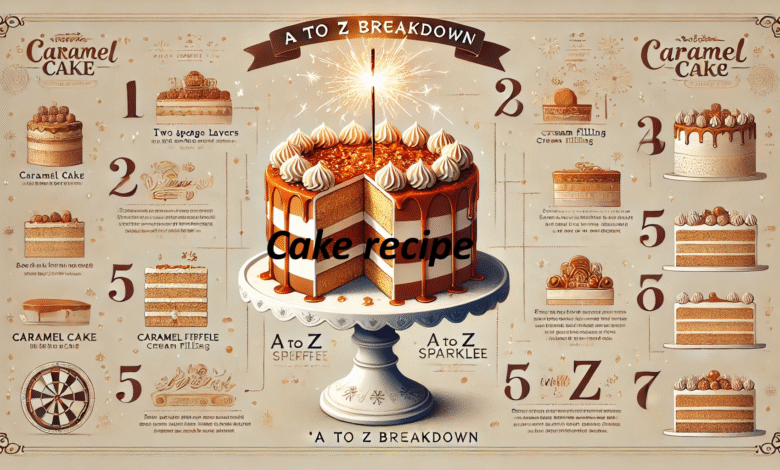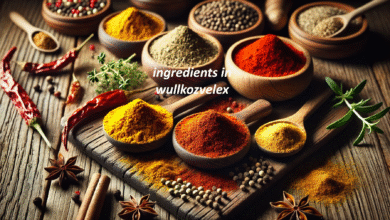The Ultimate Guide to Cake Recipes: From Basic to Brilliant

There’s Cake Recipes something magical about the moment you pull a perfectly baked cake from the oven. The golden surface, the enticing aroma filling your kitchen, and that satisfying feeling of creating something wonderful from simple ingredients – it’s what makes cake baking one of the most rewarding culinary adventures. Whether you’re a complete beginner or someone who’s been mixing batters for years, understanding the fundamentals of cake recipes will transform your baking game entirely.
The beauty of cake recipes lies in their versatility and the endless possibilities they offer. From a simple vanilla sponge that serves as the perfect canvas for creative decorating to rich chocolate cakes that satisfy the deepest cravings, each recipe tells its own story. What many people don’t realize is that once you master the basic principles behind cake making, you’ll have the confidence to experiment, adapt, and even create your own signature recipes that friends and family will beg you to make again and again.
Understanding the Foundation: Essential Ingredients in Every Great Cake Recipe
Every exceptional cake recipe starts with understanding your ingredients and how they work together to create that perfect texture and flavor. The foundation typically includes flour, which provides structure; eggs, which bind everything together and add richness; butter or oil for moisture and tenderness; sugar for sweetness and Cake Recipes texture; and leavening agents like baking powder or baking soda that give your cake its rise. Each ingredient plays a crucial role, and substituting or altering them without understanding their function can dramatically change your results.
Temperature matters more than most home bakers realize. Room temperature ingredients mix more easily and create a smoother, more uniform batter. Cold eggs straight from the refrigerator can cause your butter to seize up, while overly warm ingredients might cause your batter to curdle. The key is planning ahead – take your eggs, butter, and dairy out of the refrigerator about an hour before you plan to start baking. This simple step alone will improve the texture and rise of your cakes significantly.
Quality ingredients make a noticeable difference in your final product. While you don’t need to buy the most expensive vanilla extract or butter, choosing good-quality basics will elevate your cakes. Fresh baking powder (replace it every six months), real vanilla extract instead of artificial flavoring, and unbleached all-purpose flour create a better foundation for your baking adventures. These small investments in Cake Recipes quality ingredients will be reflected in every bite of your finished cake.
Mastering the Classic Vanilla Cake Recipe: Your Gateway to Success
The vanilla cake recipe is the cornerstone of cake baking, and mastering it opens doors to countless variations. A perfect vanilla cake should be moist, tender, with a fine crumb and a delicate vanilla flavor that isn’t overwhelming. The secret lies in the creaming method – beating butter and sugar together until light and fluffy, which incorporates air and creates that tender texture we all love. This process typically takes 3-5 minutes with an electric mixer, and you’ll know it’s ready when the mixture becomes pale and noticeably increased in volume.
The order of mixing ingredients matters tremendously in vanilla cake recipes. After creaming butter and sugar, add eggs one at a time, beating well after each addition. This ensures proper emulsification. Then alternate adding your dry ingredients and liquid ingredients, beginning and ending with the flour mixture. This technique prevents overmixing, which can lead to tough, dense cakes. Mix just until the ingredients are combined – you should still see a few streaks of flour when you stop mixing, and these will disappear as you gently fold the batter a few final times.
Baking the perfect vanilla cake requires attention to detail and patience. Preheat your oven fully before putting your Cake Recipes in – this usually takes 15-20 minutes for most home ovens. Use the toothpick test, but don’t rely on it entirely. A properly baked cake will spring back when lightly touched in the center and will just begin to pull away from the sides of the pan. Most importantly, resist the urge to open the oven door frequently, as this causes temperature fluctuations that can result in uneven baking or collapsed cakes.
Chocolate Cake Recipe Secrets: Rich, Moist, and Irresistible
Chocolate cake recipes present unique challenges and opportunities that set them apart from other cake varieties. The addition of cocoa powder changes the chemistry of your batter, often requiring adjustments to liquid ratios and leavening agents. Many professional bakers add hot coffee or hot water to chocolate cake batters – this isn’t to make coffee-flavored cake, but because hot liquid blooms the cocoa powder, intensifying the chocolate flavor and creating a more complex taste profile that will have people wondering about your secret ingredient.
The type of chocolate you choose dramatically impacts your final result. Natural cocoa powder creates a different cake than Dutch-processed cocoa, and each works better with certain leavening agents. Natural cocoa is acidic and pairs well with baking soda, while Dutch-processed cocoa is neutral and works better with baking powder. Understanding these relationships helps you troubleshoot recipes and even adapt them to use Cake Recipes ingredients you have on hand. Don’t forget about chocolate itself – adding melted chocolate to your batter creates richness, while chocolate chips or chunks provide delightful textural surprises.
Moisture is crucial in chocolate cake recipes because cocoa powder can absorb quite a bit of liquid, potentially leaving you with a dry cake. Many successful chocolate cake recipes include ingredients like sour cream, mayonnaise, or even applesauce to ensure the finished product stays moist for days. The key is balancing these additions so they enhance the chocolate flavor rather than competing with it. A truly exceptional chocolate cake should taste intensely of chocolate while maintaining a tender, moist crumb that makes each bite satisfying.
Troubleshooting Common Cake Recipe Disasters

Even experienced bakers Cake Recipes encounter cake disasters, and understanding what went wrong helps prevent future failures. Dense, heavy cakes usually result from overmixing the batter once flour is added, expired leavening agents, or using cold ingredients that don’t incorporate properly. If your cakes consistently turn out dense, check your mixing technique and ingredient temperatures. Remember that gluten development is great for bread but terrible for tender cakes – mix just until ingredients are combined after adding flour.
Cakes that dome excessively or have uneven tops often indicate oven temperature issues or improper pan preparation. An oven that runs too hot causes rapid rising and subsequent collapse, while insufficient greasing or flour dusting can cause cakes to stick and tear. Invest in an oven thermometer to verify your actual oven Cake Recipes temperature, and don’t skip the step of properly preparing your pans. Many bakers swear by making their own pan release mixture using equal parts flour, oil, and shortening beaten together – it works better than store-bought sprays for intricate pans.
Dry cakes plague many home bakers, but the solution is often simpler than you might think. Overbaking is the most common culprit – cakes continue cooking from residual heat even after removal from the oven, so slightly underbaking is better than overbaking. Environmental factors also play a role: high altitude, low humidity, or old ingredients can all contribute to dryness. Keep detailed notes about your baking conditions and results to identify patterns and adjust accordingly.
Creative Variations: Taking Basic Cake Recipes to New Heights
Once you’ve mastered basic cake recipes, the real fun begins with creative variations that showcase your personal style. Flavor additions can transform a simple vanilla cake into something extraordinary – lemon zest and juice create a bright, citrusy cake perfect for spring, while almond extract and sliced almonds provide elegant sophistication. Spices like cinnamon, cardamom, or even chai spice blends can warm up basic recipes Cake Recipes and make them perfect for fall and winter celebrations.
Texture variations add another dimension to your cake repertoire. Incorporating ingredients like shredded coconut, chopped nuts, or fresh berries creates interesting textural contrasts that make each bite more engaging. Swirl batters – where you partially mix two different flavored batters – create beautiful marbled effects that look professional but are surprisingly simple to achieve. The key is not overmixing the swirl; you want distinct ribbons of different flavors throughout your cake.
Frosting and filling combinations can completely transform the same basic cake recipe into dozens of different desserts. A vanilla cake becomes a strawberry shortcake with fresh berries and whipped cream, a sophisticated layer cake with buttercream and jam filling, or a casual sheet cake with cream cheese frosting. Learning to make different frostings and understanding how flavors complement each other allows you to create signature combinations that reflect your taste preferences and the occasion you’re celebrating.
Professional Tips for Perfect Results Every Time
Temperature control extends beyond just having room temperature ingredients – it affects every aspect of cake baking. Your kitchen’s ambient temperature influences how long ingredients take to reach room temperature, how quickly batters mix, and even how cakes bake. On particularly hot days, you might need to chill your mixing bowl and beaters to prevent butter from becoming too soft during creaming. Conversely, Cake Recipes cold kitchens might require slightly longer mixing times to achieve proper texture.
Measuring ingredients accurately is crucial for consistent results, and weight measurements are more reliable than volume measurements. A digital scale eliminates variables like how tightly flour is packed into measuring cups or whether your eggs are large or extra-large. Many professional cake recipes are written in weights for this reason. If you’re serious about improving your cake baking, investing in a kitchen scale will provide more consistent results than any other single tool.
Timing your cake baking process helps ensure everything comes together smoothly. Read through the entire recipe before starting and identify steps that can be done in advance. Many cake batters benefit from a few minutes of rest before baking, allowing the flour to fully hydrate and creating a more tender final product. Plan your mixing, baking, and cooling times so you’re not rushed – stressed baking often leads to mistakes that could have been easily avoided with better planning.
Understanding your specific oven’s quirks takes time but pays dividends in consistent results. Most home ovens have hot spots, run slightly hot or cold, or have other characteristics that affect baking. Keep notes about which racks work best for different types of cakes, whether you need to rotate pans halfway through baking, and how actual baking times compare to recipe instructions. This knowledge allows you to adapt any recipe to work perfectly in your specific baking environment, leading to consistently successful results that build your confidence and skill over time.



